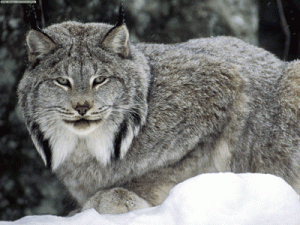For Immediate Release
November 17, 2014
November 17, 2014
Contacts:
Nick Cady, Legal Director, Cascadia Wildlands, 314-482-3746
John Mellgren, Attorney, Western Environmental Law Center, 541-525-5087
Nick Cady, Legal Director, Cascadia Wildlands, 314-482-3746
John Mellgren, Attorney, Western Environmental Law Center, 541-525-5087
Conservationists Challenge Insufficient Lynx Protection
Feds Fail to Protect Rare Cat’s Habitat in Oregon and Washington, Undermining Recovery
Feds Fail to Protect Rare Cat’s Habitat in Oregon and Washington, Undermining Recovery
EUGENE, Ore. — Today, the Western Environmental Law Center (WELC) filed suit against the U.S. Fish and Wildlife Service in federal court under the Endangered Species Act for inadequately protecting Canada lynx habitat, a  threatened species, on behalf of WildEarth Guardians, Cascadia Wildlands, Oregon Wild, and Conservation Northwest.
threatened species, on behalf of WildEarth Guardians, Cascadia Wildlands, Oregon Wild, and Conservation Northwest.
 threatened species, on behalf of WildEarth Guardians, Cascadia Wildlands, Oregon Wild, and Conservation Northwest.
threatened species, on behalf of WildEarth Guardians, Cascadia Wildlands, Oregon Wild, and Conservation Northwest. In September, USFWS announced a two-part decision expanding the protection of individual cats to wherever they are found in the Lower 48, not just in select states. However, at the same time, the agency undermined the cat’s recovery by excluding large swaths of its range from critical habitat designation.
Despite mounting evidence that lynx habitat is more expansive than previously thought, USFWS announced it will exclude all occupied lynx habitat in the Southern Rockies, and important lynx habitat in parts of Washington, Oregon, Idaho, Montana, and other states in the species’ historic, current, and available range.
“Washington is home to a very important population of rare lynx, and Oregon contains large areas of lynx-compatible habitat that are important for the future recovery of these wild cats,” said John Mellgren, Staff Attorney at the Western Environmental Law Center. “By excluding these areas, the Service is failing its obligation to ensure that lynx can recover across the American west.”
USFWS first listed lynx as a threatened species under the Endangered Species Act in 2000. The listing protects individual lynx from harm. Under the ESA, the Service is also required to designate critical habitat to ensure the long-term survival and recovery of the species. However, the Service failed to designate any critical habitat for the species until 2006. (Federal agencies are required to consult with USFWS on actions they carry out, fund, or authorize to ensure that their actions will not destroy or adversely modify critical habitat. The designation does not impact private property.)
That designation was inadequate, and after two successful lawsuits brought by conservationists in 2008 and 2010, a district court in Montana left USFWS’s meager lynx habitat protection in place, but remanded it to the agency for improvement. This resulted in still inadequate habitat designation.
Although lynx habitat is under threat throughout the contiguous U.S., the Service’s new designation again excluded much of the cat’s last best habitat in Colorado, New Mexico, Utah and Oregon from protection, and failed to protect vast tracts in Maine, Montana, Idaho, Washington, and Wyoming. The new designation also failed to protect 2,593 square miles of lynx habitat that the Service originally proposed to protect in 2013.
“The Service, through this new rule, is attempting to protect just enough areas to prevent extinction,” said Nick Cady with Cascadia Wildlands. “This bare minimum effort by the agency is indicative of a troubling pattern of ignoring the mandate to recover species so that they no longer require federal protections.”
John Mellgren and Matthew Bishop, of the Western Environmental Law Center, are representing WildEarth Guardians, Oregon Wild, Cascadia Wildlands, and Conservation Northwest in litigation challenging the Service’s inadequate lynx critical habitat designation.
###
